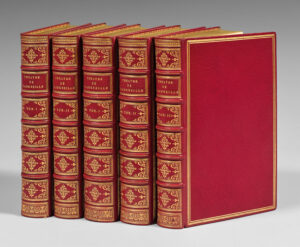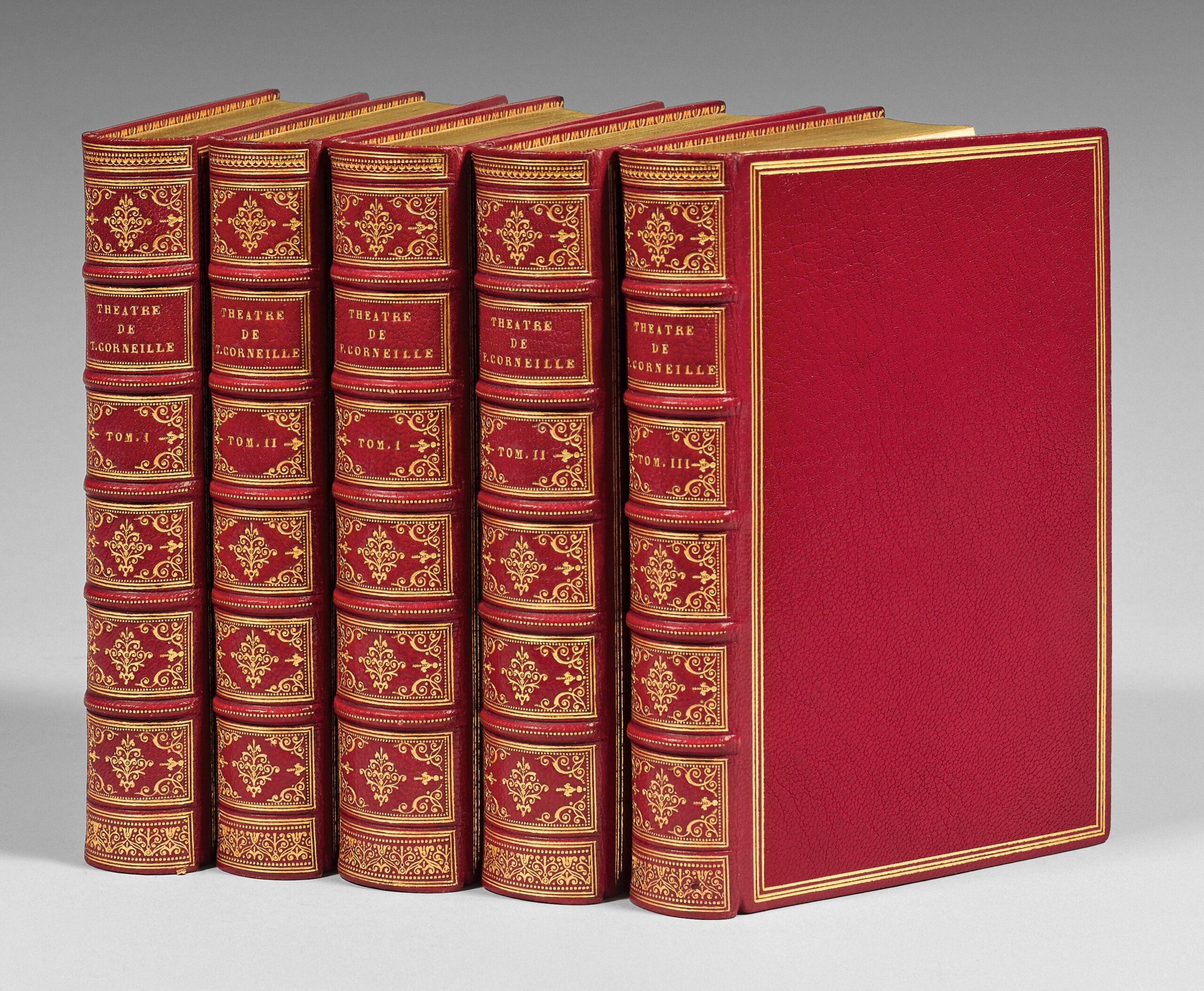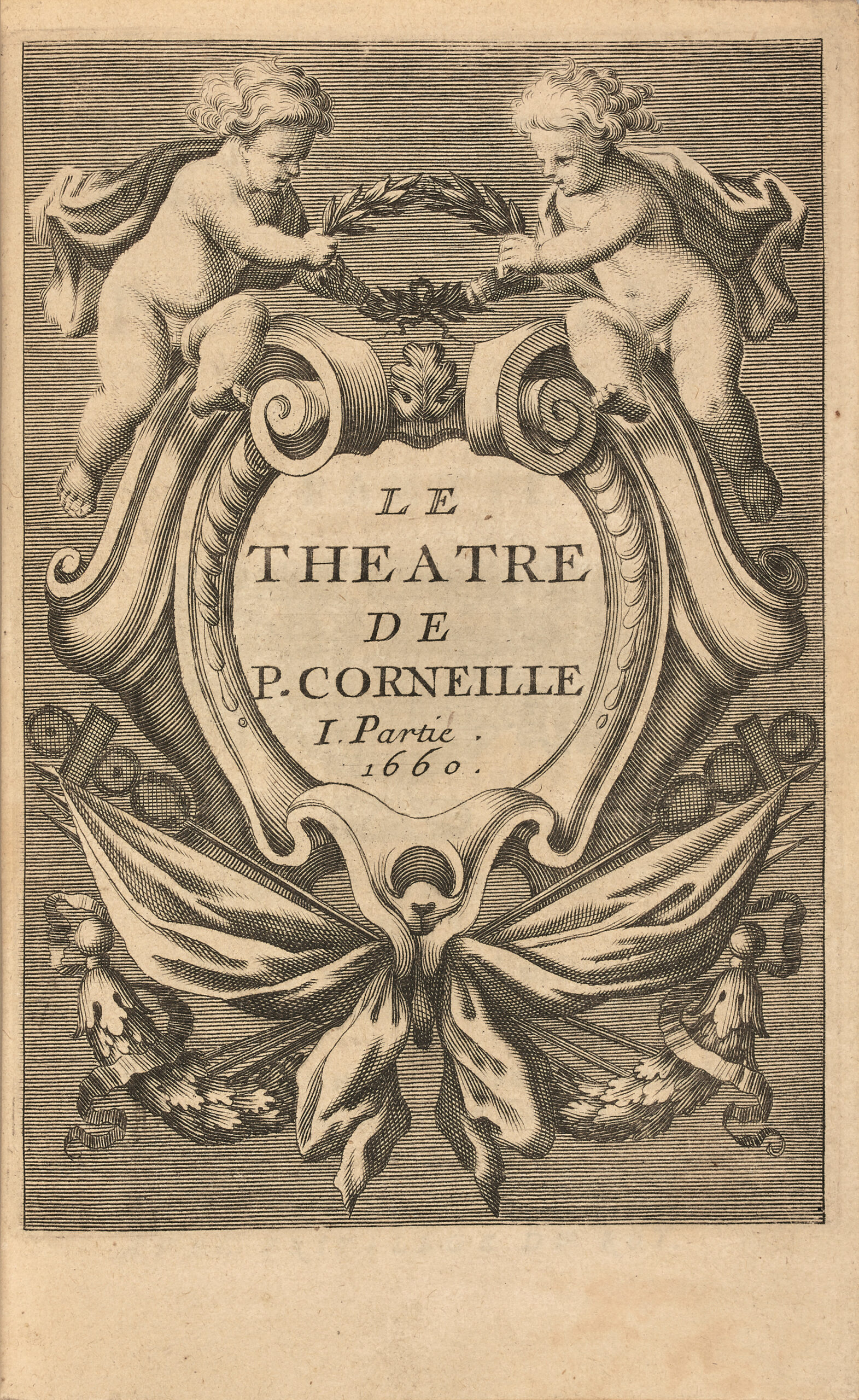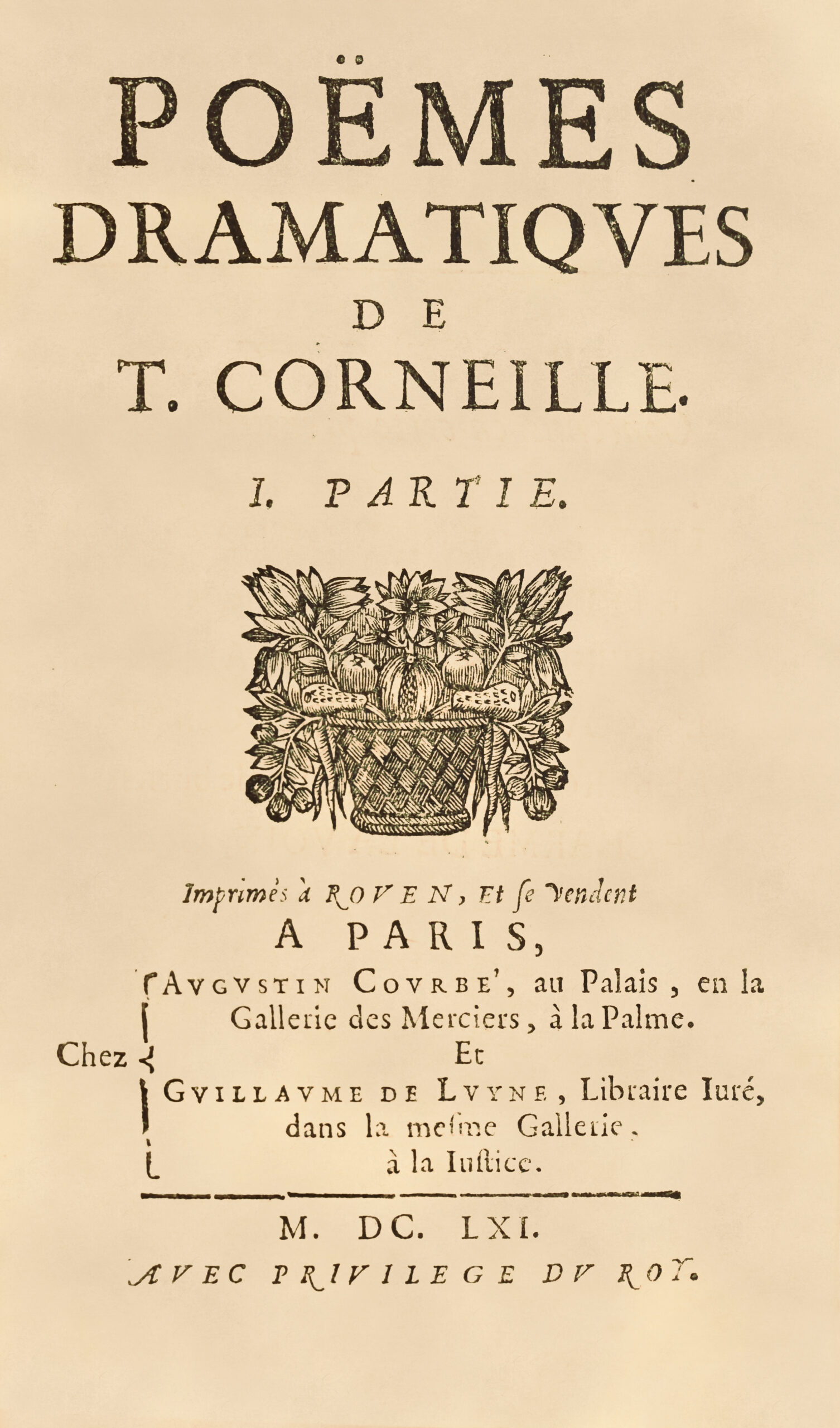Printed in Rouen, and sold in Paris, at Augustin Courbé and Guillaume de Luyne, 1660.
With royal privilege.
3 volumes 8vo.
The following two volumes printed in the same format and with the same characters are joined to this edition : – Poëmes dramatiques de T. Corneille. I. [II.] partie.
Printed in Rouen, and sold in Paris, at Augustin Courbé and Guillaume de Luyne, 1661.
With royal privilege.
2 volumes 8vo.
So in all 5 volumes small 8vo [163 x 105 mm] of : I/ xc pp., (6) pp. with 1 full page engraving, 704 pp; II/ cxvii pp., (10) pp., 720; III/ lxxxiiiiii pp., (5) pp., pp. 1 to 178, (2) ll. with a separate printing of pp. 177-178, pp. 179 to 632; I/ (2) ff., 710 pp., (2) pp. ; II/ (4) pp., 652, (4) pp., the last one blank. Red morocco, triple gilt fillet around the covers, spines ribbed with gilt fleurons, large inner gilt roulette, gilt over marbled edges. Cuzin.
The rarest of the great editions partly original of Pierre Corneille’s Works adorned with 39 copper engravings after Francis Chauveau.
Part. I : The frontispiece represents a cartouche surmounted by two Lovers holding a crown; in the center of the cartouche one reads the title and the date of 1660.
The volume contains 8 pieces (from Mélite to l’Illusion) each with a figure. The figures of Mélite, Clitandre, the Veuve, la Suivante, la Place royale, l’Illusion are signed F. C(hauveau), delin ; H. D(avid), sculp.; those of the Gallerie du Palais and Médée are signed L. S(pirinx).
Part II. : The frontispiece represents a cartouche supported by two Lovers sounding the trumpet; it bears the date of 1660. The volume contains 8 pieces placed in this order: le Cid, Horace, Cinna, Polyeucte, Pompée, Théodore, le Menteur and la suite du Menteur.
The figures of the Cid, Cinna, Polyeucte, the Menteur, the Suite du Menteur and Théodore are signed by Chauveau and David; the one of Horace is signed by Spirinx, the one of Pompée does not bear a signature.
Part III. : The frontispiece, which represents a cartouche surmounted by a basket of flowers, is dated 1660 and signed : I. Math[eus]f. The volume contains 7 pieces accompanied with 7 figures : Rodogune, Héraclius, Andromède, D. Sanche, Nicomède, Pertharite and Œdipe.
The figures of Rodogune and Don Sanche are signed by L. Spirinx; those of Héraclius, Andromède and Pertharite are signed by Chauveau and David; those of Nicomède and Œdipe are signed by Matheus.
The privilege is dated January 1653, without indication of the day; it is given for nine years to Corneille himself, who declares to yield it to Augustin Courbé and Guillaume de Luyne, according to the agreement made between them. One reads at the end: Achevé d’imprimer pour la première fois, [en vertu du présent privilège, le dernier d’octobre 1660, à Rouen, par Laurens Maurry.
In 1664, Corneille submitted his plays to a first revision; he also introduced some changes in the plays which formed the Seconde Partie published in 1648. The editions which followed reproduced faithfully the text decided then by the poet; the few variants which one notes there are generally the fact of the typographers or the result of the chance. In 1660, Corneille made a new revision of his theater. He enlarged the format he had previously adopted, made his volumes more symmetrical, put at the head of each of them a speech specially written for the edition, and some Examens in which he reviewed each of his plays.
Corneille himself tells us in a letter to the Abbé de Pure, dated August 25, 1660, of the trouble that the publication of this new collection gave him, in particular the preparation of the Discourses:
“I am, he says, at the end of a very painful Work on a very delicate matter. I have treated in three Prefaces the principal questions of the poetic art on my three volumes of Comedies. I have made some new explanations of Aristotle, and advanced some propositions, and some maxims unknown to our Ancients. I refute those on which the Academy based the condemnation of the Cid, and do not agree with Mr. d’Aubignac on all the good things he has said about me. When this appears, I have no doubt that it will give matter to the Critics, so take a little of my protection. My first Preface examines whether utility or pleasure is the goal of [the] Dramatic Poetry, of what utilities it is capable and what are its parts, both integral like the Subject and the mores, and of quantity like the Prologue, the Episode and the Exodus. In the second I treat of the conditions of the Subject of the beautiful tragedy, of what quality must be the incidents which compose it and the characters which one introduces into it in order to feel pity and fear, how is made the purgation of the passions by this pity and fear, and of the means of treating the things according to the vraysemblable or the necessary. I speak in the third of the three unitez, of action, of day and of place. I believe that after this, there are hardly any questions of importance to be stirred up and that the rest is only the embroidery that (sic) can add Rhetoric, Morality and Politics.” (Marty-Laveaux, t. Xè, pp. 486 sq.; the original is in the Bibliothèque nationale, msc. Franç., n° 12763, folio. 157 sq.)
A magnificent wide-margined copy of this partly original edition, one of the rarest and most important in the eyes of Corneille, including a separate printing of pages 177 and 178 of volume III of Corneille’s Theatre.
Provenance : Weber with ex libris.




